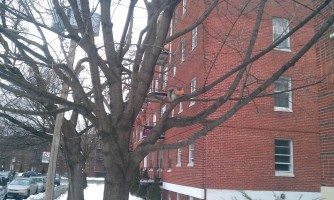
This cheeseburger won’t make me fat…will it?!
There is a lot of buzz this season about ‘fat squirrels.’ From Montreal, to Ottawa, to Toronto, social media has lit up with pictures of the fluffy squirrels.So why are people noticing heavier squirrels this year?Squirrels don’t hibernate during winter; they rely on thick layers of fat and fur to see them through the colder months.
“Every year squirrels bulk up for the winter. This year’s extended fall means they can do their pre-winter foraging for longer, which makes them fatter,” said Chris Grabas, Manager of Skedaddle Humane Wildlife Control’s Montreal operations.
Grabas says a “biological trigger” sets in when cooler temperatures arrive and the amount of daylight drops.
“What their brains are telling them is to feed and forage food,” he explained.
“The problem is they’re getting the food now because the ground isn’t frozen just yet.”
Squirrels eat a diet of nuts, seeds, plants and even insects or bird eggs are all part of their diverse diet.
The same phenomenon is playing out with other urban wildlife, such as skunks and raccoons, Grabas said.
“We’ve got a lot of calls with skunks still being active, “he said.
“We have not seen this much activity [in the past] at this time of year.”
 The warm winter will likely result in a baby boom in the spring. More animals will be able to survive the winter thanks to the extra fat storage. Mothers will be healthier, and larger litters of babies will likely be born.
The warm winter will likely result in a baby boom in the spring. More animals will be able to survive the winter thanks to the extra fat storage. Mothers will be healthier, and larger litters of babies will likely be born.
Grey squirrels breed in mid-winter, so having these squirrels going into the colder months in a healthy condition will likely allow for high reproductivity this coming winter.
During winter food is less available and less nutritious, while snow cover, cold temperatures and lack of sunlight place stress on an animal’s body condition and health. In most cases, animals are not consuming nearly as many calories as they expend to simply stay warm, perform necessary functions such as breathing, circulating blood, metabolizing fat reserves and moving about as needed.
Homeowners are being encouraged to wild proof their homes now. Animals will be looking for a warm, secure place to ride out the winter and mate. Bigger animals could mean more damage to homes this year. More babies will mean more damage to homes, attics and chimneys this spring.
Skedaddle Humane Wildlife Control, is often asked which type of animal causes the most property damage. While the truth is that just about every urban wildlife species is capable of damaging a home, the worst offenders are most certainly squirrels. It doesn’t take very long for a group or family of squirrels to inflict thousands of dollars in home damage. In fact, some of the most badly damaged attics we have seen are those that have been occupied by squirrels.
Any gaps or openings, no matter how small, which get created at the roof edge, are an open invitation for opportunistic squirrels. A bit of chewing and they are able to make a hole that suits them perfectly. Once inside the attic, they have found a warm and dry home to nest in and are not interested in leaving anytime soon.
If you suspect your home or attic is playing host to furry house-guests, give Skedaddle a call at 1.888.592.0387.
We remove squirrels in from homes and business in Kitchener-Waterloo, Cambridge, Guelph, London, Ottawa, Montreal and Halifax. Mississauga, Oakville, Burlington, Hamilton, Niagara, Sudbury, St. Catharines and Kitchener.


